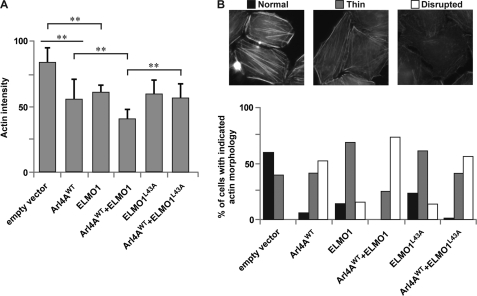FIGURE 6.
Hindrance of the Arl4A-ELMO1 complex reduces stress fiber disassembly. A, coexpression of Myc-ELMO1WT and Arl4AWT reduced F-actin intensity, indicating stress fiber disassembly, whereas coexpression of Myc-ELMO1L43A and Arl4AWT did not induce substantial stress fiber disassembly. Quantification of average fluorescence intensity of F-actin in cells expressing the indicated plasmids. Student's t test was performed to compare each condition (**, p < 0.01). B, hindrance of the Arl4A-ELMO complex reduces stress fiber disassembly. There are three different filamentous actin morphologies: (i) normal (long thick actin fibers), (ii) thin (thinner but ordered actin fibers), and (iii) disrupted (disordered thin actin fibers). Quantification of cells with different actin morphologies is shown. HeLa cells transfected with the indicated plasmids were fixed, and filamentous actin was visualized with FITC-phalloidin. ARL4A-expressing cells show thin-to-disrupted actin morphologies, with coexpression of ELMO1WT but not ELMO1L43A increasing the percentage of cells exhibiting disrupted actin morphology. For each condition, more than 60 cells were analyzed.

